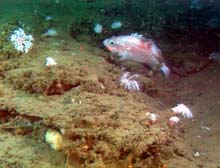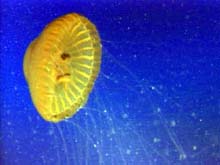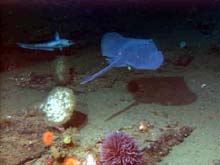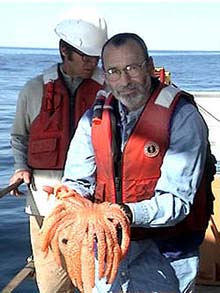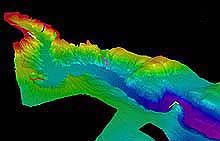
Three-dimensional image Astoria Canyon looking southeast. The head of the canyon is to the left. ROPOS dive tracks are superimposed in various colors. Click image for a larger view and for additional information about the canyon and dive tracks.
Visiting the Frontier: Diving into Astoria Canyon, June 26 – July 3, (Phase 2 of the Expedition)
The Explorers Share Their Observations
After a week at sea intently watching video from the ocean depths and examining biological and geological specimens brought to the surface, the Lewis and Clark Legacy Expedition explorers offer some preliminary observations on their scientific voyage of discovery.
Waldo Wakefield, Lynn Yamanaka, and Mary Yoklavich
Research Fisheries Biologists
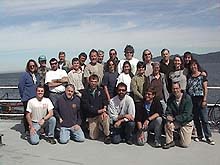
Lewis and Clark Legacy Expedition scientists aboard the NOAA ship Ron Brown. Click image for larger view.
Expedition biologists debated the species name of this common rockfish of the upper canyon wall. Click image for larger view.
Benthic Fish Habitats in Astoria Canyon
Mary Yoklavich, Lynn Yamanaka, and Waldo Wakefield spent the last few days exploring benthic fishes and their habitats in Astoria Canyon. In the recent past, all three of these biologists have used a small, occupied submersible to document fish habitats on isolated seamounts off British Columbia, the heads of submarine canyons off central California, and varied geological formations off southeastern Alaska. The unique opportunity to explore a little known geographic province with a highly advanced, deepwater remotely operated vehicle (ROV) such as ROPOS, deployed from the state-of-the-art NOAA Ship Ronald H. Brown, was not to be missed.
While each of the scientists brings a unique perspective to this expedition, they shared some general expectations. They were curious to see if the relationships between fish and their habitats, as described in their respective research programs, could be applied in Astoria Canyon. They also wanted to learn more about the identification of these deepwater fish in their natural surroundings, rather than lying dead on the deck of a boat or on the ice in a fish market. From their experience, these fish look surprisinly different when viewed underwater, and all of the traditional guides were found to have limited value. In fact, only a handful of scientists are honing the techniques necessary to recognize these diverse groups of deep-dwelling benthic fish.
During this expedition, there was limited time to explore fish in their habitats, due to the competing interests of fellow explorers in other disciplines. However, the fish biologists were encouraged from their initial observations that the patterns of fish in specific habitats that they described elsewhere were also observed in Astoria Canyon. The shallow portions of the canyon's walls (150-300 m) included rugged rock outcrops, which harbor some of the same species of rockfish that are found at such depths on rocky banks and in canyon heads elsewhere along the West Coast. The most common members of this shallow community in Astoria Canyon are sharpchin, greenstriped and rosethorn rockfish. What was surprising were the low numbers and diversity of fish, and, in fact, some expected species were absent altogether. For instance, in about 10 hrs of exploring these rocky habitats, only one yelloweye, one widow, one canary, and three yellowtail were seen; the scientists found this a bit perplexing!
One interesting observation was the abundance and patchy distribution of small halibut (about 60 cm) that aggregated along a broad bench (or step) on the canyon wall at 220 m water depth. Coincident with these halibut was a relatively dense swarm of krill and a couple of yellowmouth rockfish.
A very different guild of fish were found on the sediment-covered sea floor in deep water, below 350 m: two species of thornyheads (affectionately known in the fishing community as "idiots"), all sorts of eelpouts (zoarcids), at least two types of flatfish (Dover and deep-sea sole), and, of course, the ever present hagfish. All of these species are found in similar habitat along the coast. Noticeably missing was one of the more common families of fish that is ubiquitous worldwide in deep water, the rattails or grenadiers.
Dr. Wakefield, Ms. Yamanaka, and Ms. Yoklavich will continue to work together to integrate their research, which collectively encompasses the entire West Coast of North America, to advance our understanding of deep-dwelling fishes and their habitats.
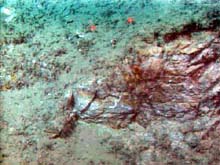
A submarine landslide exposed this mudstone scar devoid of marine life and sediment, indicating recent mass-wasting activity. Click image for a larger view.
Bob Embley
Marine Geologist and Geophysicist
Relationships between Biologic and Geologic Processes in Astoria Canyon.
The ROPOS ROV dives and other data collected over the past week at Astoria Canyon have produced views of complex habitats determined by the geologic history of the canyon. One of the major influences on habitat for rockfish and invertebrates is the history of erosion and mass wasting so dramatically revealed on the canyon walls. The ebb and flow of currents and the input of nutrients and suspended matter superimposed on the eroded walls of the canyon produce unique habitat for a large array of bottom-dwelling fish and invertebrates. In the upper canyon, a dramatic example of this was revealed on the north wall, where the tops of large slump blocks formed a mosaic of jumbled blocks that hosted a specialized array of invertebrates and probably provides refuge for a variety of rockfish. On our last dive, at more than 1,000 m in the canyon axis, a lush community of deepwater corals was discovered on this wall. The dive site was chosen because it offered an opportunity to investigate the eroded face of a ridge of sediment that had been formed during the long history of compression along the Cascadia Margin. Why was this site host to such unique biota? We're not sure, but it may have something to do with its unique location. perpendicular to the canyon axis. where currents provide a constant supply of nutrients.
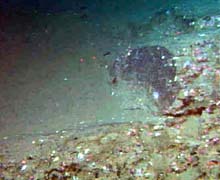
The dark-colored rock represents a freshly broken rock face devoid of organisms. This is in stark contrast to the sedimented and colonized adjacent rock, which is host to a diverse array of benthic invertebrates. Click image for larger view.
Chris Goldfinger
Marine Geologist and Geophysicist
Astoria Canyon Seismicity Studies
The results from this cruise will take time to assimilate, but we now have a suite of samples from numerous landslides along the canyon that will be used to assess the physical properties of the sediments that might be expected to fail in a future great earthquake. Together with the high-resolution bathymetric map and sidescan sonar data collected during this project, these samples will allow us to estimate the shaking required for these slope failures to occur. In addition to the mapping and soft sediment sampling, we collected several rock samples from deep levels in the accretionary wedge. These samples represent some of the oldest rocks that make up the active part of the Juan de Fuca-North America tectonic plate boundary. By taking the ROV ROPOS to the base of a ridge eroded by the canyon, we were able to sample deep levels that otherwise would have been accessible only by deep-sea drilling. These samples will be dated, telling us the age of the accretionary wedge. They will also be tested for shear strength, adding to our knowledge of the properties of the plate boundary that lie within the "locked" portion of the Cascadia megathrust system. The geology of the canyon reflects 40 million yrs of subduction along the Cascadia Margin. In the canyon walls, we could see the history of modern sediment accretion, as well as evidence of an older accretionary phase, and basin filling near the head of the canyon. The different rocks control the erosion patterns along the canyon walls, revealing this long history.
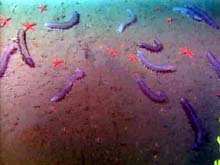
Aggregations of sea cucumbers and seastars on the soft, mud bottom of Astoria Canyon. Click image for a larger view.
As ocean explorers journeyed between sonar targets on ROPOS dive R597 (its second dive of the expedition), a brilliant jellyfish (Poralia) drifted by with long tentacles undulating. Click image for a larger view.
Brian Tissot
Marine Ecologist and Associate Professor of Environmental Science
Invertebrate Ecology and Habitats
Astoria Canyon exhibits a low diversity of habitats and their associated invertebrate communities relative to other areas of similar depth on the Oregon continental shelf. The canyon floor, from depths of 500 to 1,000 m, is characterized by high levels of particulate matter raining down onto a soft sediment bottom. The surface is composed of soft, loose sediments, punctuated by burrows from a variety of animals, indicating high levels of nutrients and a high density of infaunal invertebrates. The epifauna is dominated by sea cucumbers and seastars that occasionally occur in very high densities (greater than 10 per sq m). Sea pens, shrimp, stalked octocorals and patches of brittle stars are also observed in this habitat. Moving from the sea floor to the canyon walls, there is a pronounced shift in the composition of macroinvertebrates as hard substrates become more common at shallower depths (to 150 m). Soft sediments at the base and slope of the canyon floor give way to irregular rocky outcrops of soft mudstone on the canyon walls. In this habitat, the tentacular plumes of Psolid sea cucumbers are very common, attached to rocks buried in sediment and on the steep walls. Also found on the rocky walls of the canyon are a variety of sponges, seastars, octocorals, anemones, and crinoids.
Bill Pearcy
Biologist
Biological Observations
As the ROV ROPOS descends through the depths of the Astoria Canyon, a tremendous number of particles streak by. They are detritus, sometimes called "marine snow," because they look like snowflakes. Some of the particles originate from land, transported by the Columbia River; others are produced in the ocean by the decay of plants and animals.
Among the pelagic animals we see are comb jellies with iridescent, sparkling bands, and long, rope-like siphonophores. Then, in deeper water, below 200 m, red shrimp with long antennae hang in midwater by day, while silver-bodied lantern fish, repelled by the bright lights, flash away. Near the bottom, we see whitish eelpouts swimming by, or curled and immobile. We also see transparent squids, and once, a vicious-looking viperfish, right on the sea floor. At one location, we observed the remnants of a mass mortality of midwater krill that had fallen to the bottom. Apparently, this is the first time that this has been observed anywhere.
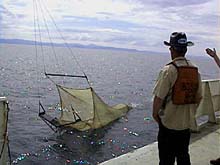
Mid-water trawls, like the one shown here, were used in conjunction with bioacoustic profiling to study the fish and invertebrates of Astoria Canyon. Click image for larger view.
Ed Bowlby, Marine Biologist, and
Mary Sue Brancato, Marine Biologist and Toxicologist
Biological Observations
This cruise has provided an excellent opportunity to observe an ROV, in this case the ROPOS, doing survey operations and sampling procedures in Astoria Canyon. It has helped us to determine the applicability of comparable surveys in the submarine canyons of the Olympic Coast National Marine Sanctuary, where we work. It would be fascinating to explore our nearby Quinault Canyon, and even our most northerly Juan de Fuca Canyon, to observe the similarities and differences between habitat features and associated benthic communities. The cruise also highlighted the need for high-resolution multibeam bathymetry maps to plan dives and geological and biological sampling efforts in the sanctuary.
One of the most surprising aspects of the exploration of Astoria Canyon was the extent of mudstone and soft sediments, the paucity of fish, and the abundance of benthic invertebrates. The subtle changes in habitat and benthic organism communities were interesting, particularly when substrate changes weren't obvious to the eye, from areas of plentiful, filter-feeding sea cucumbers to areas of 5-armed seastars and deposit-feeding sea cucumbers, to areas of 10-armed stars, brittlestars and sea pens, to sea floors coated with hydroids, bryozoans and polychaete tubes. These often seemed like discrete communities. The mid-water trawl tows on the NOAA Ship Ron Brown, and thefish trawls on a separate vessel, provided a fascinating element that is of critical importance in understanding trophic links to fish, seabirds and marine mammals. Viewing the wide variety of planktonic life was exciting!
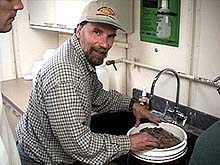
Ric Brodeur, a fisheries oceanographer , sorts the catch of krill, lantern fish, shrimp and squid from a mid-water trawl. Click image for a larger view.
Ric Brodeur
Fisheries Oceanographer
Trawl Observations
Using the small Isaac Kidd mid-water trawl (IKMT) aboard the NOAA Ship Ron Brown, we were able to target the mid-water layers seen in the acoustic profiles. We were only able to sample during the daytime, when the scattering layer is in mid-water (150-200 m). Catches have predominantly been euphausids (krill) in terms of biomass, but other important sound scatterers, such as myctophid fish (lanternfish), midwater squid, and shrimp, were also abundant. Catches have been sorted in the lab and were frozen for later biochemical and stable isotope analysis.
The fishing vessel Sea Eagle has been sampling selected locations in mid-water and on the bottom to identify the larger acoustic targets seen in the bioacoustic surveys. Its first tow consisted of a large catch (5,000 lb) of rockfish. Subsequent tows aimed at different layers caught whiting and some of the same small mid-water organisms caught in the IKMT. The last tows used the bottom-trawl gear to collect sablefish and other near-bottom fish, as well as invertebrates seen in the ROPOS videos. In addition to species and size composition, these trawls will provide useful samples to examine age, food habits, and stable isotope composition back in the laboratory.
Ed Baker
Oceanographer
CTD Operations
The hydrography program conducted nine CTD (conductivity, temperature and depth) casts along and across the axis of Astoria Canyon. Our goals were to describe the distribution of temperature, salinity, fine particulate matter, nutrients, and trace metals within the canyon, especially in relation to the distribution of small fish and plankton. Most of the analyses from these casts will be done onshore after the cruise. A preliminary look at the data, however, shows the presence of several layers of particulate matter in the water column. In the upper few meters, we plainly see the warm and turbid water of the Columbia River plume, spreading thinly over the local seawater. Deeper, we see layers of particles eroded off the continental shelf by currents and carried into the deeper waters of the canyon, plus layers of increased turbidity related to swarms of fish and plankton. Finally, just above the sea floor is a perpetual layer of particles, resuspended from the sea floor by tidal currents moving up and down the canyon.
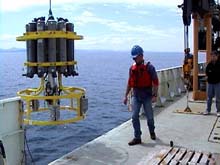
The NOAA ship Ronald H. Brown's chief bosun deploys the CTD during an equipment check in the Strait of Juan de Fuca. Click image for larger view.
This assemblage of underwater fauna -- a black skate (middle), grenadier (upper left), sponges and anemones (foreground) -- represents the rich and diverse creatures found in the deeper portions of Astoria Canyon. In this image we see. Click image for larger view.
Gordon Hendler, Curator of Echinoderms at the Natural History Musum of Los Angeles County, CA, retrieves a large seastar gathered by the ROV ROPOS. Click image for larger view.
We also deployed two moorings containing current meters and temperature sensors. One mooring was placed at approximately the midpoint of the canyon, against its southern wall. The second was deployed south of the canyon mouth, at the edge of the continental shelf. These measurements will be used to assess the oceanographic conditions under which biologically important material moves up or down the canyon. The research vessel Wecoma will recover the two moorings in early August.
Lynne Yamanaka
Fisheries Biologist
Biological Observations
It was exciting to witness the exploration unfolding, literally from the bottom up, using the most advanced technologies available. The canyon was surveyed, the data processed, and the resulting maps used to determine dive locations for the ROV ROPOS. The canyon substrate, vertebrates and invertebrates (both benthic and pelagic), as well as the water column, were sampled, all on one cruise! For me, it was fascinating to be transported to the depths by the ROPOS to witness the fish and invertebrates in the canyon ecosystem. Most of my past experiences with fish sampling have been aboard fishing vessels. Incorporating any ecosystem links to rockfish stock assessment must come from these broader experiences. The opportunity to interact with the other 25 scientists on this cruise was a highlight for me. What better way to learn than to observe and discuss the science while it is being conducted?
Gordon Hendler
Invertebrate Zoologist
Invertebrate Specimen Collecting
More than 90 percent of the astounding variety of animals in Astoria Canyon are invertebrates (sponges, corals, seastars, snails, worms, and so on). To understand the ecology of the canyon, and to comprehend the exciting video footage taken by the ROV ROPOS, we must accurately identify the invertebrates, some of which have almost certainly never been seen before. In order to name the species, it is absolutely necessary to collect and preserve individuals that can be studied in detail and compared with specimens in museum collections.
I have packed all of the specimens from the dives. They fill 35 gallon-sized containers, each holding many animals. The collections, carefully prepared, labeled, and bottled in alcohol, will be shipped to the Natural History Museum of Los Angeles County, California, the largest natural history museum on U.S. West Coast. At the museum, they will be studied and named by experts. They will serve as a reliable and permanent record of the species inhabiting the canyon, so that they can be used by scientists and students in the future.
Sign up for the Ocean Explorer E-mail Update List.






























